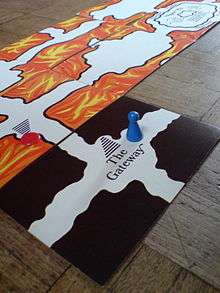The Sorcerer's Cave
| A game of exploration, magic, and adventure | |
|---|---|
 | |
| Designer(s) | Terence Donelly |
| Publisher(s) | Ariel, Philmar, Gibson |
| Players | 1–4 |
| Setup time | 1–5 minutes |
| Playing time | 1-3 hours |
| Random chance | Moderate |
| Skill(s) required | Strategy, Luck |
The Sorcerer's Cave, a game of exploration, magic, and adventure, is a fantasy board/card game designed by Terence Peter Donnelly and first published in 1978. It was inspired by the fantasy role-playing game Dungeons & Dragons.[1] The game can be played solo or competitively, with player(s) controlling a party of adventurers who explore a multi-level dungeon which is randomly generated by drawing area cards from a deck. The party will encounter monsters, allies and treasures, and will ultimately escape with their riches or find their doom.
Playing
Player(s) start by selecting a party from the various encounterable characters in the game. Characters are differentiated by Fighting Strength, Magic Power and various unique abilities. All explorers start on the central "Gateway" tile, and progress by drawing area tiles (tunnel, chamber, or various special chambers). If the tile is a chamber, the player then draws a number of smaller 'encounter' cards, and must deal with the characters/objects drawn. Encounter cards represent valuables, magical items and characters. Assuming characters are present, the player must either withdraw, attack or approach - in which case a dice roll determines whether characters are neutral, friendly (joining your party) or hostile (prepare for combat).
The winning player is the one who escapes the cave with the most treasure. Rules for both solo play and competitive play are given, with several variations on victory conditions offered.
Inspiration and Assessment
Donnelly wrote that, after trying Dungeons & Dragons, that "while I had enjoyed being a participant in a fantasy role-playing adventure, I wasn't ready to do the work needed to set one up... if only the concept could be translated into a format that would require no laborious set-up and no referee—a game that could be taken out of the box and played instantly, yet be different every time."[1]
Ian Livingstone said of the Sorcerer's Cave "As a family game, for the hour or two playing with the kids type market The Sorcerer's Cave works, and works well, but real Fantasy buffs will be disappointed by its simplicity when compared to D&D and the like."[2]
Computer versions
Donnelly has created a version of The Sorcerer's Cave for Microsoft Windows computers, which is available from his website. The ZX Spectrum computer game, Goblin Mountain, by Martin Page (from Sinclair User 63 - Jun.1987) also has clear similarities (especially the Friendly/Indifferent/Hostile reactions by strangers).
Legacy
An expansion set called The Sorcerer's Cave Extension Kit, containing 30 extra cave tiles and additional cards, was published in 1980. Mystic Wood, another somewhat different randomly generated maze game designed by Donnelly, is a spiritual successor to Sorcerer's Cave set in a forest with each player having their own specific quest.[3]
References
- 1 2 A memoir by the designer of The Sorcerer's Cave and Mystic Wood from BoardGameGeek
- ↑ Livingstone, Ian. "Open Box Review". White Dwarf (#7).
- ↑ Davidson, Andy. "Open Box Review". White Dwarf (#20).
- Computer and Video Games review of Diggles computer game which uses The Sorcerer's Cave as a reference and describes the game.
- Inform Fiction - The Reliques of Tolti-Aph interactive fiction inspired by The Sorcerer's Cave which describes the game.
External links
- The Sorcerer's Cave and The Sorcerer's Cave Extension Kit at BoardGameGeek
- Computer version of the game created by the author
- The Type Fantastic page with download of Goblin Mountain